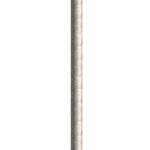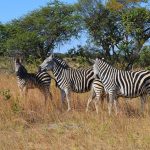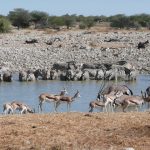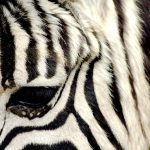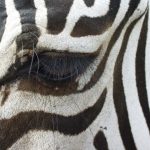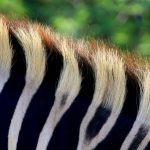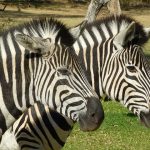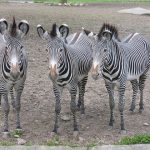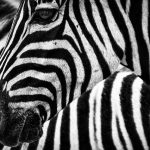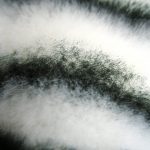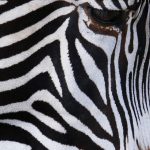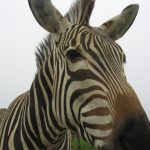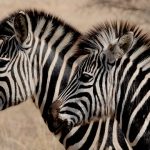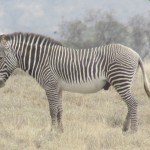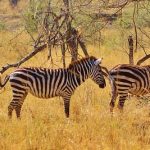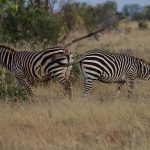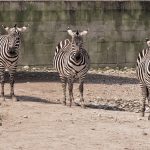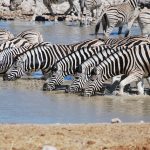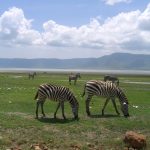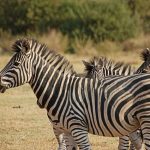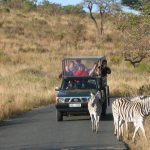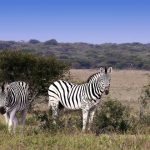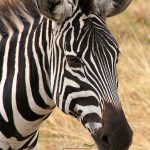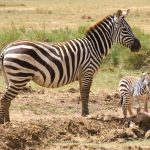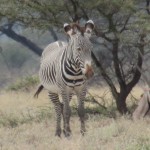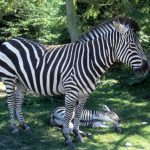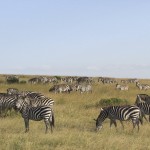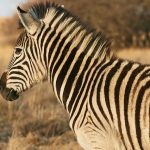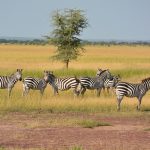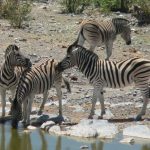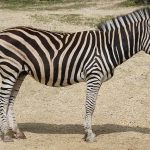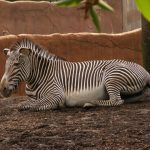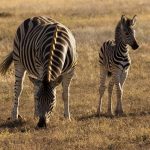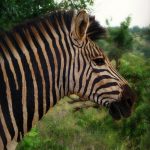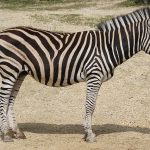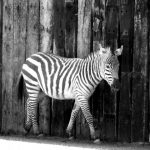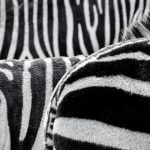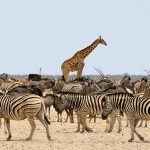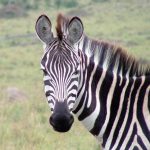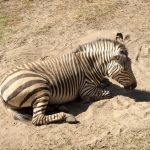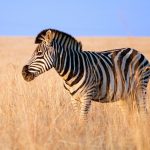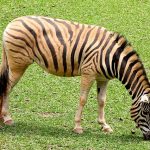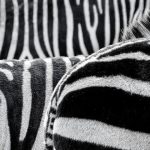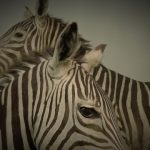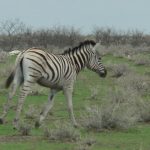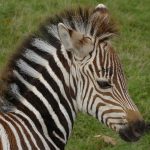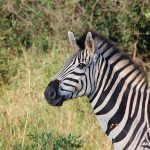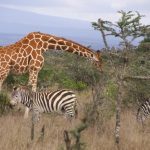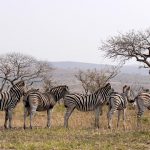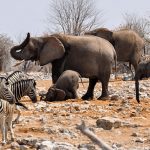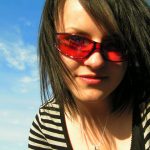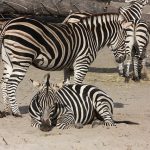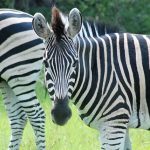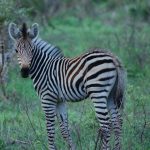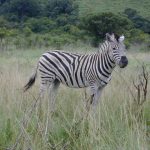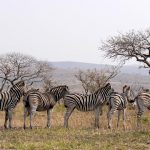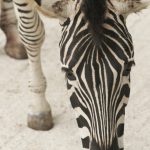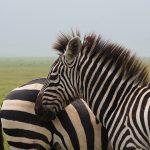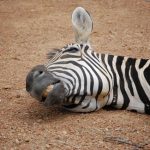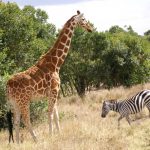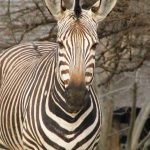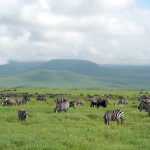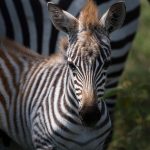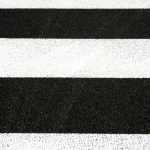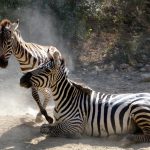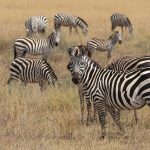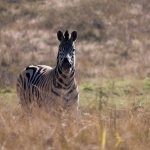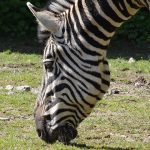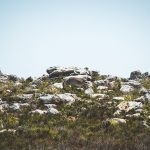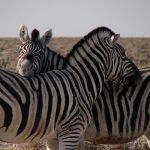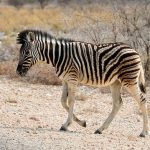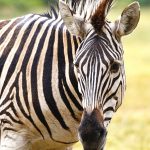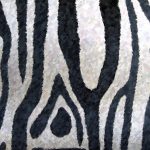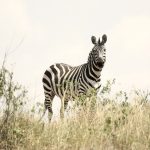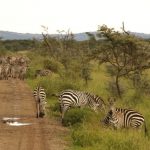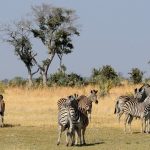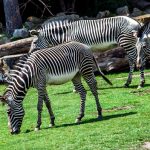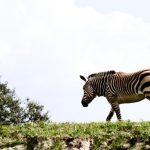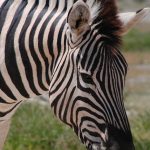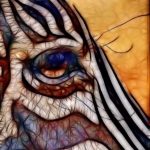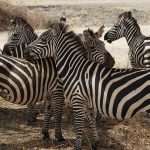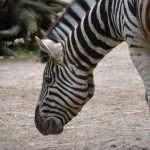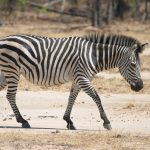- Zebras may occasionally eat herbs, bark, leaves, shrubs, and twigs although they feed almost entirely on grasses
- The three species of zebras are the plains zebras, the mountain zebras and the Grevy’s zebra
- A group of zebras standing or moving together appear as one mass of flickering stripes to the predators
- The mountain zebras are classified as vulnerable
- Quagga Project breed zebras that are similar to the quagga that became extinct in the 19th century
- Zebras may occasionally eat herbs, bark, leaves, shrubs, and twigs
- Zebra’s stripes are horizontal on the legs and at the rear
- Bitings insets and predators are confused by the stripes of a moving zebra
- Mountain zebra is smaller than Grevy’s zebras
- Fertile hybrids occur between Grevy’s zebra and plains zebras in certain regions of Kenya
- The stripes of a zebra confuse predators by motion dazzle
- The adult males of Grevy’s zebra live alone
- Grévy’s zebra is the largest type of zebras
- Bachelor males either live with groups of other bachelors or alone
- The mountain zebra tends to have narrower strips than plains zebra
- A group of zebras moving together appear as one mass of flickering stripes to the predators
- When zebras move the stripes confuse predators and biting insects
- Thorny scrublands is one of the habitats of zebras
- Plains zebra belong to the subgenus Hippotigris
- Equus zebra zebra is the scientific name of Cape Mountain zebra
- Zebras have four gaits: trot, walk, canter and gallop
- The subspecies of plains zebra are distributed across much of Eastern and Southern Africa
- Grevy’s zebra is the rarest species
- A zebra’s stripes are unique to each individual
- Zebras have excellent hearing and rounder and larger ears than horses
- Equus quagga boehmi is the scientific name of Grant’s zebra
- Zebras prefer to graze with each other
- The long narrow heads of Grevy’s zebra make it appear mule-like
- The mountain zebra tends to have a sleek coat
- Savannas, mountains, woodlands, thorny scrublands, grasslands and coastal hills are some of the habitats of zebras
- Mountain zebra belongs to the subgenus Hippotigris
- Zebras have four gaits: gallop, canter, trot, and walk
- Zebras may occasionally eat herbs, shrubs, twigs, leaves and bark
- The camouflage hypotheses of the evolution of zebra’s stripes has been contested because the predators of a zebra are more likely to have heard or smelled a zebra, especially at night
- Zebra species do not interbreed
- Equus quagga quagga is the scientific name of quagga
- Zebras are very protective about their group members
- Predators and biting insects are confused by the stripes of a moving zebra by motion dazzle
- When a predator is sensed or spotted, a zebra will bray loudly
- Quagga Project is responsible for the process of breeding zebras that are similar to the quagga that became extinct in the 19th century
- Selous’ zebra is a type of plains zebra
- Zebra species have overlapping ranges
- A zebra’s ears are pushed forward when it is frightened and stand erect when it is in a tense, calm, or friendly mood
- Zebras may occasionally eat twigs, herbs, bark, leaves, and shrubs
- Embryological evidence suggests that zebra’s background color is black and the bellies and white stripes are additions
- Plains zebras and mountain zebras live in groups
- Zebras may occasionally eat herbs, bark, shrubs, twigs, and leaves
- The stripes of a zebra are effective in attracting fewer flies especially tabanid horseflies and blood-sucking tsetse flies
- Zebras has superb hearing and eyesight
- Chester Zoo
- Zebras communicate with whinnying and high-pitched barks
- Grevy’s zebras appear rather mule-like
- Zebra foals are protected by mothers
- Zebra is closely related to donkeys, horses, and asses
- Zebras are polyphyletic
- When zebras move the stripes confuse biting insects and predators
- A zebra’s stripe pattern is unique
- Crosses between zebras and other equines are called zebroid, zeedonk, zony, and zorse
- In certain regions of Kenya, fertile hybrids occur between Grevy’s zebra and plains zebras
- Zebras will stand with ears erect and head held high when surveying an area for predators
- Crosses between zebras and other equines are called zony, zorse, zebroid, and zeedonk
- Zebras only sleep when neighbors are around
- Grevy’s zebra is an inhabitant of the grasslands of northern Kenya and Ethiopia
- Zebra is closely related to horses, donkeys, and asses
- Zebra is closely related to asses, donkeys and horses
- Horse and donkey are the closest relatives to zebra
- Bitings insets and predators are confused by the stripes of a moving zebra by motion dazzle
- Chapmans
- Zebras have more stripes in warmer habitats
- The stripes of a zebra confuse predators by motion dazzle and the vertical stripes of zebra disrupts its outline when hiding in the grass
- Zebras have larger and rounder ears than horses
- The plains zebra is the most common type of zebras and has six subspecies
- A group of zebras moving or standing together appear as one mass of flickering stripes to the predators making it more difficult for them to pick out a target
- Donkey and horse are the closest relatives to zebra
- Like other ungulate, a zebra can turn its ears in almost any direction
- Horse is a closest relative to zebra
- A couple of Zebras, photo taken at Khama Rhino Sanctuary, Botswana.
- Zebras are united by their black and white striped coats
- Grevy’s zebras have narrow long heads
- Donkey is a closest relative to zebra
- Plain zebras are also known as common zebras
- A zebra is a brave animal
- The ultimate origin of the name “zebra” is uncertain
- The predators of a zebra cannot see well at a distance
- The largest type of zebras are Grévy’s zebra
- Zebras are highly social animals
- In the 19th century quagga became extinct
- When cornered, the zebra will kick or bite its attacker
- Zebra’s eyes give it a wide field of view
- Zebras may occasionally eat herbs, shrubs, twigs, leaves and bark although they feed almost entirely on grasses
- The predators of a zebra cannot see well at a distance and are likely to have heard or smelled a zebra, especially at night
- The stripes of a zebra are effective in attracting tabanid horseflies and blood-sucking tsetse flies
- Horses are generally faster than zebras
- Burchell’s zebra is a type of plains zebra
- Zebra belongs to Equidae family
- Zebras feed almost entirely on grasses
- Zebra belongs to Equus genus
- The vertical stripes of a zebra disrupts its outline when hiding in the grass and the the stripes of a zebra confuse predators by motion dazzle
- The vertical stripes of zebra disrupts its outline when hiding in the grass
- A group of zebras moving or standing together appear as one mass of flickering stripes to the predators
- Dolichohippus is one of the subgenus of zebra
- The etymology of the name “zebra” is uncertain
- Family
- Equus quagga crawshayi is the scientific name of Crawshay’s zebra
- Zebras have excellent hearing
- A group of zebras standing or moving together appear as one mass of flickering stripes to the predators making it more difficult for the predators to pick out a target
- Zebras will only sleep in the company of others so that they can warn each other of predators
- A zebra’s ears indicate its mood
- Zebras will stand in an alert posture when surveying an area for predators
- Equus zebra hartmannae is the scientific name of Hartmann’s Mountain zebra
- The foals of Grevy’s zebra stay with their mothers
- The narrow long heads of Grevy’s zebra make it appear mule-like
- The mountain zebra tends to have a white belly
- Equus quagga chaplain is the scientific name of Chapman’s zebra
- Zebra is closely related to donkeys, asses, and horses
- In captivity, mountain zebras have been crossed with plain zebras
- A zebra has superb eyesight and hearing
- Quagga is a type of plains zebra
- The traditional hypotheses of the evolution of the stripes of zebras relates to camouflage
- Hunting has severely impacted zebra population
- Mountain zebra is endangered
- Zebras are generally slower than horses
- Zebras feed entirely on grasses
- When a predator is sensed or spotted, a zebra will bark loudly
- Grevy’s zebra is classified as endangered
- Breeding back is a process of breeding zebras that are similar to the quagga that became extinct in the 19th century
- Zebras have four gaits: walk, trot, canter, and gallop
- A zebras resembles an ass
- Zebras evolved within the last 4 million years
- Equus zebra is one of the species of zebra
- Equus zebra is the scientific name of Mountain zebra
- Zebra belongs to Chordata phylum
- Zebra foals are able to walk and suckle shortly after birth
- Zebra belongs to Perissodactyla order
- Zebra is closely related to asses, horses and donkeys
- Grevy’s zebra is an inhabitant of the grasslands of Ethiopia and northern Kenya
- In captivity, crosses between other equines and zebras have produced several distinct hybrids
- Zebras are subject to the same common diseases and infections of the domestic horse
- Zebra’s stripes are vertical on the neck, head, forequarters, and main body and horizontal on the legs and at the rear
- Crosses between zebras and other equines are called zorse, zebroid, zeedonk, zony, and zeedonk
- Plains zebras and mountain zebras live in groups, called as “harems”
- The three species of zebras are the plains zebras, the Grevy’s zebra, and the mountain zebras
- Predators and bitings insets are confused by the stripes of a moving zebra
- Equus grevyi is one of the species of zebra
- A zebra’s stripes come in different patterns
- Grevy’s zebra is endangered
- Crosses between zebras and other equines are called zeedonk, zorse, zebroid, zeedonk, and zony
- Zebras have superb eyesight and hearing
- A group of zebras standing together appear as one mass of flickering stripes to the predators making it more difficult for them to pick out a target
- Zebra foals are protected by mothers, the other mares and the head stallion of the group
- The three species of zebras are the Grevy’s zebra, the plains zebras, and the mountain zebras
- A harem consists of one stallion and up to six mares and foals
- Savanna is one of the habitats of zebras
- Mountain is one of the habitats of zebras
- Zebra is closely related to an ass
- A zebra brays or barks
- A zebra’s ears are pulled backward when it is angry
- Quagga Project breed zebras that are similar to the quagga that became extinct in the late 19th century
- A zebra’s ears stand erect when it is in a tense, calm, or friendly mood and are pushed forward when it is frightened
- The predators of a zebra cannot see well at a distance, especially at night
- A group of Grevy’s zebras stays together only for a few months
- Zebras often groom each other
- Grassland is one of the habitats of zebras
- Zebras have four gaits: walk, trot, canter, and gallop
- Stripes are used to cool the zebra
- Zebras have excellent eyesight
- The digestive systems of zebras allow them to live on diets of lower nutrition than that of other herbivores
- A zebra’s ears are pushed forward when it is frightened and pulled backward when it is angry
- Bachelor males either live with groups of other bachelors or alone until old enough to challenge a stallion
- Mountain zebra and the Grevy’s zebra are endangered
- Zebras have four gaits: canter, trot, walk, and gallop
- A group of zebras standing or moving together appear as one mass of flickering stripes to the predators making it more difficult for them to pick out a target
- Grant’s zebra is a type of plains zebra
- A zebra foal is not black and white but brown and white at birth
- Female zebras mature earlier than males
- Grévy’s zebra is the only species of subgenus Dolichohippus
- A zebra’s closest relatives and horses and donkeys
- Wildebeest and Zebras in Maasai Mara, analogue Shot from 1995
- A zebra foal is not black and white at birth
- Chapman’s zebra is a type of plains zebra
- A zebra’s ears are pushed forward when it is frightened, pulled backward when it is angry and stand erect when it is in a tense, calm, or friendly mood
- Quagga became extinct in the 19th century
- Zebras may occasionally eat herbs, bark, shrubs, twigs, and leaves although they feed almost entirely on grasses
- Fertile hybrids occur between plains zebras and Grevy’s zebra in certain regions of Kenya
- Quagga Project is responsible for breeding zebras that are similar to the quagga that became extinct in the 19th century
- The camouflage hypotheses of the evolution of zebra’s stripes has been contested because the predators of a zebra cannot see well at a distance
- The etymology of the name “zebra” is unknown
- SONY DSC
- Grevy’s zebra is larger than mountain zebras
- Equus quagga is one of the species of zebra
- Zebras sleep standing up
- A zebra foal is brown and white at birth
- The ultimate origin of the name “zebra” is unknown
- Hunting for skins and habitat destruction and has severely impacted zebra population
- When cornered, the zebra will bite or kick its attacker
- The process of breeding zebras that are similar to the quagga that became extinct in the 19th century is called breeding back
- The three species of zebras are the plains zebras, the mountain zebras and the Grevy’s zebra
- Zebras can never be domesticated
- A zebra has superb hearing and eyesight
- Zebra is closely related to horses, asses, and donkeys
- The name “zebra” dates back to c. 1600
- The striping pattern of a zebra is unique to each individual
- A zebra’s ears are pushed forward when it is frightened and pulled backward when it is angry
- The three species of zebras are the Grevy’s zebra, the mountain zebras and the plains zebras, and the
- A zebra can turn its ears in almost any direction
- A zebra’s ears stand erect when it is in a tense, calm, or friendly mood
- Equus quagga selousi is the scientific name of Selous’ zebra
- Predators and biting insects are confused by the stripes of a moving zebra by the wagon-wheel effect and the barber pole illusion
- A group of zebras moving together appear as one mass of flickering stripes to the predators making it more difficult for them to pick out a target
- Habitat destruction has severely impacted zebra population
- Habitat destruction and hunting for skins has severely impacted zebra population
- A zebra’s ears are pulled backward when it is angry
- The predators of a zebra cannot see well at a distance and are likely to have heard or smelled a zebra
- Habitat destruction and hunting has severely impacted zebra population
- Woodlands is one of the habitats of zebras
- The stripes of a zebra are effective in attracting fewer tabanid horseflies and blood-sucking tsetse flies
- The camouflage hypotheses of the evolution of zebra’s stripes has been contested
- A zebra barks or brays
- Quagga Project breed zebras that are similar to the quagga
- Equus quagga is the scientific name of Plains zebra
- Zebras have acute senses of taste and smell
- Zebra belongs to Hippotigris and Dolichohippus subgenus
- When tense, zebras snort
- Equus quagga borensis is the scientific name of maneless zebra
- Zebra foals are protected by mothers, head stallion and the other mares
- Zebras belong to animalia kingdom
- Hippotigris is one of the subgenus of zebra
- Maneless zebra is a type of plains zebra
- The mountain zebra and the plains zebra belong to the subgenus Hippotigris
- Zebra’s stripes are horizontal on the legs and at the rear and vertical on the neck, head, forequarters, and main body
- The plains zebra is the most common type of zebras
- Zebras have night vision
- A zebra’s ears stand erect when it is in a tense, calm, or friendly mood, pushed forward when it is frightened and pulled backward when it is angry
- Zebra’s stripes are vertical on the neck, head, forequarters, and main body
- Zebras have a herd mentality
- Zebra’s night vision is not as advanced as that of their predators
- Zebras have rounder and larger ears than horses
- Although zebra’s have night vision it is not as advanced as that of their predators
- Crosses between zebras and other equines are called zorse, zebroid, zeedonk, and zony
- Grevy’s zebras have long narrow heads
- Coastal hills is one of the habitats of zebras
- Zebras are several species of African equids
- A lone zebra takes a walk along a grassy ridge towards the protective shaded of some nearby trees.
- Grevy’s zebra is an inhabitant of northern Kenya and Ethiopia
- Plains zebras are much more plentiful than other species of zebras
- A baby zebra is called foal
- Zebra’s stripes are caused by a combination of factors
- NYC Natural history museum
- A zebras has a slight resemblance an ass
- Equus quagga burchellii is the scientific name of Burchell’s zebra
- Zebras have four gaits: walk, canter, trot, and gallop
- The common plains zebra can weigh up to 350 kg
- Zebras may occasionally eat twigs, herbs, bark, leaves, and shrubs although they feed almost entirely on grasses
- Grevy’s zebra is an inhabitant of Ethiopia and northern Kenya
- There are three species of zebras
- Zebra populations are diverse
- A zebra’s closest relatives and donkeys and horses
- A group of zebras standing together appear as one mass of flickering stripes to the predators
- Hunting and habitat destruction has severely impacted zebra population
- The camouflage hypotheses of the evolution of zebra’s stripes has been contested because the predators of a zebra are more likely to have heard or smelled a zebra
- Crawshay’s zebra is a type of plains zebra
- A zebra’s great stamina helps it outrun predators
- A zebra’s ears are pushed forward when it is frightened
- The zig-zag manner in which zebras run when chased makes it more difficult for predators to attack
- The predators of a zebra cannot see well at a distance and are likely to have heard or smelled a zebra, especially at night
- Zebra belongs to Mammalia class
- At a distance the vertical stripes of zebra merges to an apparent grey
- Breeding back is a process of breeding zebras that are similar to the quagga that became extinct in the late 19th century
- Zebras have a symbiotic relationship with some birds
5 facts about zebras
- Grevy’s zebras are found on the savannahs of northern Kenya
- Plain zebras are mostly restricted to certain parts from Sudan to northern Zimbabwe
- Mountain zebras can be seen in southwestern Africa
- Zebra stripes come in different patterns and are unique to each individual
- There are three species of zebras: plains zebra, Grévy’s zebra and mountain zebra
To receive a colourful digibook about Zebra with videos, images and text, please fill out the following form or simply email us on safaris@safari-center.com






